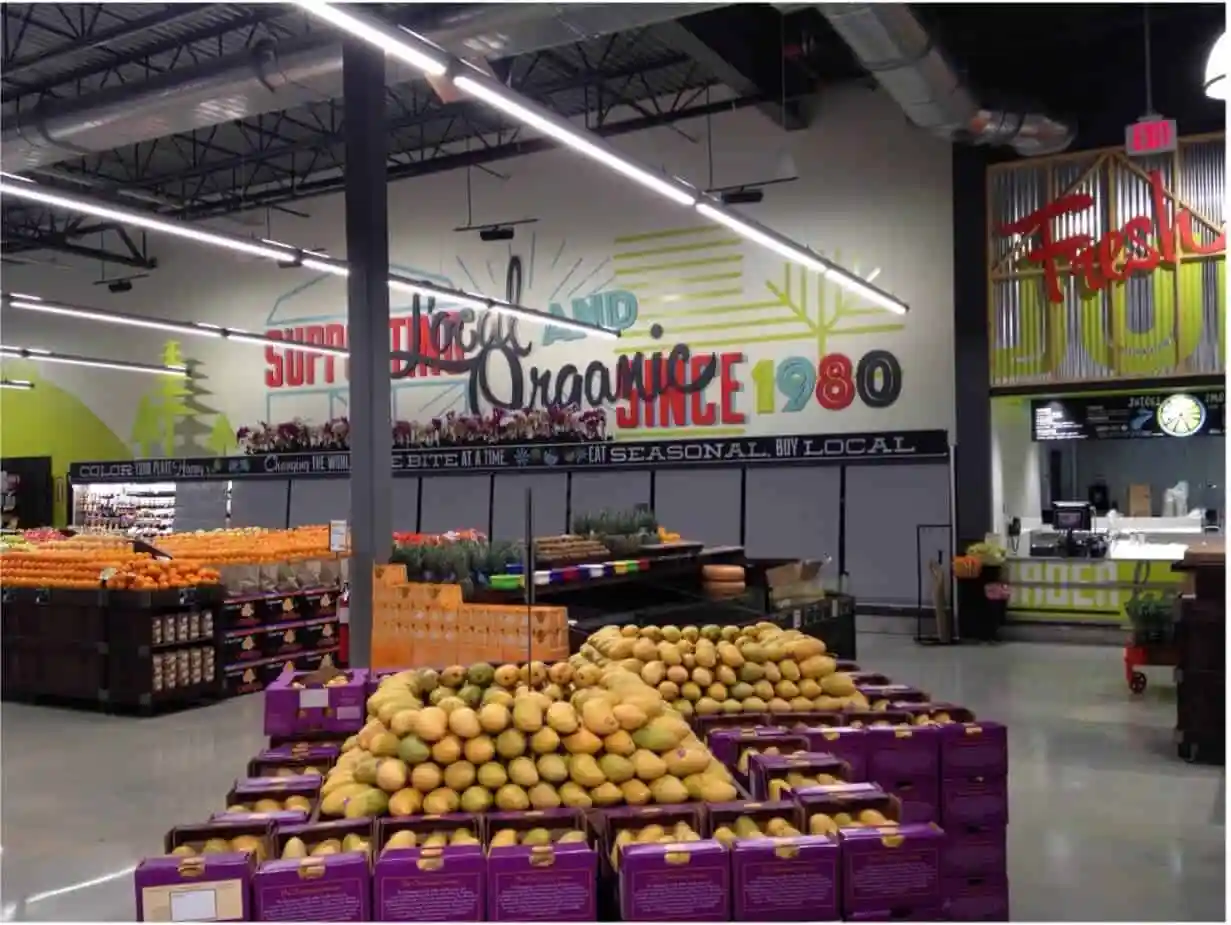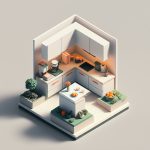Imagine grocery shopping as an adventure, a journey through a captivatingly designed space. Every detail, from the lighting to the display shelves, works together to create an extraordinary experience that makes shopping a breeze. Welcome to the world of grocery store interior design, where we’ll unveil the secrets behind these retail havens. Get ready to discover the tricks and techniques that turn average aisles into visual feasts and make your grocery runs a true delight.
Grocery Store Interior Design: Crafting a Captivating Customer Journey
We all know the feeling of walking into a well-designed store – it just makes the whole shopping experience better! That’s the power of grocery store interior design, which goes beyond aesthetics to create a harmonious blend of practicality, a great customer experience, and smart operational strategies. It’s about crafting a space that welcomes, guides, and delights shoppers at every turn.
Creating an Easy Flow and Setting the Mood
Imagine strolling through wide, well-lit aisles that showcase products like works of art – that’s the magic of strategic aisle organization and lighting. It’s about creating a space that feels open and inviting, allowing customers to navigate effortlessly while strategically highlighting the freshest produce or the aroma of freshly baked bread.
Speaking of aromas, don’t underestimate the power of ambiance! Soft lighting in the bakery section creates a warm, inviting feel, while vibrant colors in the produce section evoke a sense of freshness and vitality. Color is a powerful tool, influencing emotions and subtly guiding purchasing decisions. Think calming blues and greens in the checkout area to promote tranquility, or energetic reds and oranges to encourage impulse buys in the snack aisle.
Welcoming Entrances and Smooth Sailing
First impressions are everything. A welcoming entrance draws customers in, setting the tone for their entire shopping trip. Imagine being greeted by the aroma of freshly brewed coffee or the sight of vibrant floral displays – it’s about creating an immediate sense of delight and anticipation.
Once inside, efficient traffic flow keeps customers moving smoothly. Wide aisles, strategically placed displays, and clear signage act as a roadmap, guiding shoppers effortlessly through the store. Designated areas for online order pickups and self-checkouts cater to the needs of today’s busy shopper, streamlining the experience and minimizing wait times.
Design that Makes You Feel Something
A well-designed grocery store is a feast for the senses. Visual harmony, achieved through a cohesive blend of colors, textures, and even greenery, transforms a mundane space into a visually appealing and inviting environment. Imagine encountering a soothing water feature or a living wall of herbs – these elements create a sense of tranquility and connection with nature, enhancing the overall shopping experience.
Remember those strategically placed colors we talked about? Color psychology plays a significant role in shaping customer behavior. Calming blues in the checkout area can reduce stress and encourage patience, while vibrant yellows in the bakery section stimulate appetite and encourage impulse buys.
Tech-Savvy Shopping for the Win
In today’s digital age, technology integration is paramount. Behind the scenes, sophisticated inventory management systems ensure shelves are always stocked, while real-time data analysis provides valuable insights into customer behavior. Imagine a world where your grocery store anticipates your needs, alerting you to special offers on your favorite items as you browse.
On the customer-facing side, digital conveniences such as mobile checkout, personalized deals, and interactive displays enhance convenience and engagement. Imagine scanning your groceries as you shop, bypassing the checkout line entirely, or using augmented reality to take a virtual tour of the store and locate specific items.
What are the Elements of Effective Grocery Store Interior Design?
Effective grocery store interior design is a carefully orchestrated symphony of elements working together to create a seamless and enjoyable shopping experience. It’s about understanding customer behavior and using design principles to guide their journey, enhance their experience, and ultimately, boost sales.
Let’s break down the key ingredients of this recipe for success:
1. Smooth Sailing: Navigation and Flow:
- Strategic Aisle Placement: Wide, strategically placed aisles ensure smooth customer flow and prevent bottlenecks. Placing popular items at the back of the store encourages customers to navigate through different sections, increasing product exposure and potential impulse buys.
- Intuitive Layout: A clear and logical layout makes it easy for customers to find what they need. Grouping related items together, like baking supplies in one area, simplifies the shopping experience and minimizes frustration.
- Clear Signage: Visible and easy-to-read signage acts as a roadmap, guiding customers to specific departments and products. This is especially crucial for large supermarkets where navigating can feel overwhelming.
2. Creating a Welcoming Vibe: Comfort and Ambiance:
- Inviting Lighting: Natural light is ideal, but strategically placed artificial lighting can create a warm and inviting atmosphere. Consider using different types of lighting to highlight specific areas or product displays.
- Comfortable Seating: Providing seating areas allows customers to take a break, especially important for the elderly or those with young children. These areas can also serve as social spaces, fostering a sense of community within the store.
- Pleasant Aromas and Sounds: Engaging the senses enhances the shopping experience. The smell of freshly baked bread or subtly diffused essential oils can create a welcoming ambiance. Playing calming music can also enhance the mood and encourage customers to linger longer.
3. Tech to the Rescue: Technology Integration:
- Self-Checkout Kiosks: These offer convenience and reduce wait times, especially beneficial during peak hours. They also appeal to tech-savvy shoppers and those with smaller purchases.
- Mobile Apps and Loyalty Programs: Mobile apps can provide personalized offers, shopping lists, and even in-store navigation. Loyalty programs incentivize repeat purchases and provide valuable customer data.
- Digital Signage and Interactive Displays: Digital signage can display dynamic content like promotions or new product information. Interactive displays can provide detailed product information, recipes, or even allow customers to order customized items.
4. Eye Candy: Visual Appeal:
- Color Scheme: A well-chosen color scheme can evoke desired emotions and highlight specific areas. Using contrasting colors for signage ensures readability and accessibility.
- Texture and Materials: Incorporating natural elements like wood or stone can create a warm and inviting atmosphere. Using different textures for flooring can help define spaces and guide customer flow.
- Focal Points and Visual Merchandising: Creating eye-catching displays with unique themes or seasonal promotions draws attention and encourages impulse buys. Using lighting to highlight these displays further enhances their appeal.
By focusing on these key elements, grocery stores can create a customer-centric environment that is both functional and aesthetically pleasing. A happy customer is more likely to become a loyal customer, returning for their weekly grocery hauls again and again!
How Does Grocery Store Interior Design Influence Customer Behavior?
Grocery store interior design is a powerful tool that, when implemented strategically, can subtly influence customer behavior, guiding their movement, encouraging purchases, and fostering a positive emotional connection with the brand.
Guiding the Grocery Run: The Power of Layout
- Strategic Product Placement: Ever notice how essential items like milk or eggs are often located at the back of the store? This is a deliberate tactic to maximize customer exposure to other products as they navigate through the aisles.
- Creating a Flow: Supermarkets often use a circular flow pattern, guiding customers on a predetermined route through the store. This ensures exposure to a wider variety of products and increases the likelihood of impulse buys.
- Point of Sale (POS) Displays: Placing enticing items like magazines or candy near the checkout lines targets customers during those last-minute purchase decisions.
Setting the Mood with Lighting and Color
- Lighting Techniques: Bright lighting in the produce section highlights the freshness and vibrancy of fruits and vegetables. Warm, inviting lighting in the bakery section enhances the aroma and visual appeal of baked goods.
- Color Psychology in Action: Warm colors like red and orange are known to stimulate appetite, which is why you’ll often find them in fast food restaurants and snack aisles. Cool colors like blue and green create a sense of calm and relaxation, making them suitable for checkout areas or customer service desks.
Engaging the Senses for a Memorable Experience
- Sensory Marketing: Grocery stores are masters at appealing to all five senses. From the smell of freshly brewed coffee to the sound of soothing music, these sensory cues create a multi-sensory environment that enhances the overall shopping experience.
- Creating Atmospheres: Different sections of the store can have distinct atmospheres. The produce section might evoke a bustling farmers’ market feel, while the deli section might have a more intimate and gourmet ambiance.
- Encouraging Interaction: Sampling stations, cooking demonstrations, and interactive displays provide opportunities for customers to engage with products, creating a more memorable and positive shopping experience.
What are the Latest Trends in Grocery Store Interior Design?
Today’s grocery stores are ditching the sterile, utilitarian look of the past and embracing design trends that prioritize customer experience, sustainability, and technological integration. Here are some of the hottest trends shaping the future of grocery retail:
1. Embracing the Power of Biophilic Design: Incorporating natural elements into the store design, such as living walls, natural light, and organic materials, creates a calming and inviting atmosphere. Imagine shopping in a space that feels more like a greenhouse than a grocery store – it’s about connecting customers with nature and promoting a sense of well-being.
2. Creating a Sense of Community: Grocery stores are evolving into community hubs, offering spaces for shoppers to connect and socialize. Think comfortable seating areas with charging stations, in-store cafes, and even community events or workshops. It’s about fostering a sense of belonging and transforming the grocery store from a transactional space to an experiential destination.
3. Personalization Is Key: From personalized product recommendations to tailored shopping experiences, technology is enabling grocery stores to cater to individual customer preferences. Imagine receiving a notification on your phone as you walk past your favorite cereal brand, alerting you to a special offer or suggesting a complementary product.
4. Sustainability Takes Center Stage: Consumers are increasingly eco-conscious, and grocery stores are responding by implementing sustainable design practices. This includes using energy-efficient lighting and appliances, sourcing locally produced goods, minimizing food waste, and incorporating recycled and recyclable materials in the store design.
5. Technology Enhances, Not Overwhelms: Technology is seamlessly integrated into the shopping experience, enhancing convenience and personalization without feeling intrusive. Think self-checkout kiosks with intuitive interfaces, mobile apps that allow customers to scan and bag items as they shop, and interactive displays that provide product information, recipes, and nutritional data.
These trends reflect a shift in consumer expectations, where grocery shopping is no longer just about purchasing necessities; it’s about seeking out experiences that are enjoyable, convenient, and aligned with personal values. By embracing these trends, grocery stores can create a competitive edge, attracting new customers and fostering long-lasting loyalty.
Citation:
Grocery Store Interior Design Trends: 5 Key Elements.
Explore More Interior Design Inspiration:
Admire the beauty of French modern interior design where classic French elegance meets contemporary chic. Discover inspiration for creating a peaceful atmosphere in funeral home interior design. Enhance your design knowledge by exploring good interior design magazines that showcase the latest trends and ideas.
- Kitchen Counter Corner Ideas: Style Your Awkward Angles Now - December 31, 2025
- Best Finish for Butcher Block Countertops: Choosing the Right Option - December 30, 2025
- Seal for butcher block: Find the best food-safe finish - December 29, 2025










